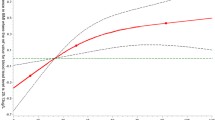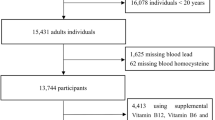Abstract
We aimed to determine whether lead exposure was associated with cardiovascular diseases (CVD) and risk factors in Chinese adults. Five thousand three hundred and forty-eight subjects were enrolled from 16 sites in China. Blood lead level (BLL) was measured by atomic absorption spectrometry. Cardiovascular diseases included coronary heart disease, stroke, and myocardial infarction. Cardiovascular risk factors included body mass index (BMI), fasting plasma glucose (FPG), lipid profile, and blood pressure. We found that 5.9% of the study population had prevalent CVD. Medians (interquartile range) of BLLs were 44.00 μg/L (29.00–62.48) for men and 37.70 μg/L (25.00–54.60) for women. The prevalence of CVD gradually and markedly increased with increasing BLL quartiles in women (P for trend < 0.01), but not in men. After adjustment for age, current smoking, and drinking, BLLs were independently associated with cardiovascular risk factors including BMI, FPG, and blood pressure in women (all P < 0.05), but not in men. Binary logistic regression showed that increased quartiles of BLL were significantly and positively associated with increased odds ratio of prevalent CVD (P for trend < 0.01) in women. This association was independent of age, smoking, drinking, education, diabetes, obesity, hypertension, and lipid profile. In conclusion, BLL in the range currently considered acceptable is independently associated with CVD, which is the leading cause of death in China. Further practical and cost-effective efforts to reduce lead exposure may be warranted.


Similar content being viewed by others
References
Ahamed M, Siddiqui MK (2007) Low level lead exposure and oxidative stress: current opinions. Clin Chim Acta; Int J Clin Chem 383:57–64
Arnold LW, Hoy WE, Wang Z (2015) Low birth weight and large adult waist circumference increase the risk of cardiovascular disease in remote indigenous Australians—an 18 year cohort study. Int J Cardiol 186:273–275
Barker DJ, Osmond C, Golding J, Kuh D, Wadsworth ME (1989) Growth in utero, blood pressure in childhood and adult life, and mortality from cardiovascular disease. BMJ (Clinical research ed) 298:564–567
Bell S, Daskalopoulou M, Rapsomaniki E, George J, Britton A, Bobak M, Casas JP, Dale CE, Denaxas S, Shah AD, Hemingway H (2017) Association between clinically recorded alcohol consumption and initial presentation of 12 cardiovascular diseases: population based cohort study using linked health records. BMJ (Clinical research ed.) 356:j909
Bhatnagar A (2006) Environmental cardiology: studying mechanistic links between pollution and heart disease. Circ Res 99:692–705
Chang HR, Tsao DA, Yu HS, Ho CK (2005) The change of beta-adrenergic system after cessation of lead exposure. Toxicology 207:73–80
Chen C, Wang N, Zhai H, Nie X, Sun H, Han B, Li Q, Chen Y, Cheng J, Xia F, Zhao L, Zheng Y, Shen Z, Lu Y (2016) Associations of blood lead levels with reproductive hormone levels in men and postmenopausal women: results from the SPECT-China study. Sci Rep 6:37809
Ding Y, Gonick HC, Vaziri ND (2000) Lead promotes hydroxyl radical generation and lipid peroxidation in cultured aortic endothelial cells. Am J Hypertens 13:552–555
Faulk C, Barks A, Liu K, Goodrich JM, Dolinoy DC (2013) Early-life lead exposure results in dose- and sex-specific effects on weight and epigenetic gene regulation in weanling mice. Epigenomics 5:487–500
Flegal KM, Kruszon-Moran D, Carroll MD, Fryar CD, Ogden CL (2016) Trends in obesity among adults in the United States, 2005 to 2014. JAMA 315:2284–2291
Hu SS, Kong LZ, Gao RL, Zhu ML, Wang W, Wang YJ, Wu ZS, Chen WW, Liu MB (2012) Outline of the report on cardiovascular disease in China, 2010. Biomed Environ Sci 25:251–256
Jee SH, Suh I, Kim IS, Appel LJ (1999) Smoking and atherosclerotic cardiovascular disease in men with low levels of serum cholesterol: the Korea Medical Insurance Corporation Study. JAMA 282:2149–2155
Jeong SW, Lee CK, Suh CH, Kim KH, Son BC, Kim JH, Lee JT, Lee SW, Park YB, Lee JW, Yu SD, Moon CS, Kim DH, Lee SY (2014) Blood lead concentration and related factors in Korea from the 2008 National Survey for Environmental Pollutants in the Human Body. Int J Hyg Environ Health 217:871–877
Kilander L, Berglund L, Boberg M, Vessby B, Lithell H (2001) Education, lifestyle factors and mortality from cardiovascular disease and cancer. A 25-year follow-up of Swedish 50-year-old men. Int J Epidemiol 30:1119–1126
Kim Y, Lee BK (2012) Associations of blood lead, cadmium, and mercury with estimated glomerular filtration rate in the Korean general population: analysis of 2008-2010 Korean National Health and Nutrition Examination Survey data. Environ Res 118:124–129
Li MM, Cao J, Xu J, Cai SZ, Shen XM, Yan CH (2014) The national trend of blood lead levels among Chinese children aged 0-18 years old, 1990-2012. Environ Int 71:109–117
Lind PM, Olsen L, Lind L (2012) Circulating levels of metals are related to carotid atherosclerosis in elderly. Sci Total Environ 416:80–88
Lu J et al (2014) The relationship between insulin-sensitive obesity and cardiovascular diseases in a Chinese population: results of the REACTION study. Int J Cardiol 172:388–394
Lustberg M, Silbergeld E (2002) Blood lead levels and mortality. Arch Intern Med 162:2443–2449
Menke A, Muntner P, Batuman V, Silbergeld EK, Guallar E (2006) Blood lead below 0.48 micromol/L (10 microg/dL) and mortality among US adults. Circulation 114:1388–1394
Mozaffarian D et al (2016) Heart disease and stroke statistics-2016 update: a report from the American Heart Association. Circulation 133:e38–360
Navas-Acien A, Selvin E, Sharrett AR, Calderon-Aranda E, Silbergeld E, Guallar E (2004) Lead, cadmium, smoking, and increased risk of peripheral arterial disease. Circulation 109:3196–3201
Nawrot TS, Thijs L, Den Hond EM, Roels HA, Staessen JA (2002) An epidemiological re-appraisal of the association between blood pressure and blood lead: a meta-analysis. J Hum Hypertens 16:123–131
Nie X, Wang N, Chen Y, Chen C, Han B, Zhu C, Chen Y, Xia F, Cang Z, Lu M, Meng Y, Jiang B, Jensen MD, Lu Y (2016) Blood cadmium in Chinese adults and its relationships with diabetes and obesity. Environ Sci Pollut Res Int 23:18714–18723
Peters JL, Kubzansky LD, Ikeda A, Fang SC, Sparrow D, Weisskopf MG, Wright RO, Vokonas P, Hu H, Schwartz J (2012) Lead concentrations in relation to multiple biomarkers of cardiovascular disease: the Normative Aging Study. Environ Health Perspect 120:361–366
Revis NW, Zinsmeister AR, Bull R (1981) Atherosclerosis and hypertension induction by lead and cadmium ions: an effect prevented by calcium ion. Proc Natl Acad Sci U S A 78:6494–6498
Rodrigo R, Passalacqua W, Araya J, Orellana M, Rivera G (2003) Implications of oxidative stress and homocysteine in the pathophysiology of essential hypertension. J Cardiovasc Pharmacol 42:453–461
Schafer JH, Glass TA, Bressler J, Todd AC, Schwartz BS (2005) Blood lead is a predictor of homocysteine levels in a population-based study of older adults. Environ Health Perspect 113:31–35
Schober SE, Mirel LB, Graubard BI, Brody DJ, Flegal KM (2006) Blood lead levels and death from all causes, cardiovascular disease, and cancer: results from the NHANES III mortality study. Environ Health Perspect 114:1538–1541
Solenkova NV, Newman JD, Berger JS, Thurston G, Hochman JS, Lamas GA (2014) Metal pollutants and cardiovascular disease: mechanisms and consequences of exposure. Am Heart J 168:812–822
Tsoi MF, Cheung CL, Cheung TT, Cheung BM (2016) Continual decrease in blood lead level in Americans: United States National Health Nutrition and Examination Survey 1999-2014. Am J Med 129:1213–1218
Vaziri ND (2002) Pathogenesis of lead-induced hypertension: role of oxidative stress. J Hypertens Suppl 20:S15–S20
Wang N, Chen C, Nie X, Han B, Li Q, Chen Y, Zhu C, Chen Y, Xia F, Cang Z, Lu M, Meng Y, Zhai H, Lin D, Cui S, Jensen MD, Lu Y (2015a) Blood lead level and its association with body mass index and obesity in China—results from SPECT-China study. Sci Rep 5:18299
Wang N, Wang X, Han B, Li Q, Chen Y, Zhu C, Chen Y, Xia F, Cang Z, Zhu C, Lu M, Meng Y, Chen C, Lin D, Wang B, Jensen MD, Lu Y (2015b) Is exposure to famine in childhood and economic development in adulthood associated with diabetes? J Clin Endocrinol Metab 100:4514–4523
Wang N, Zhai H, Han B, Li Q, Chen Y, Chen Y, Xia F, Lin D, Lu Y (2016) Visceral fat dysfunction is positively associated with hypogonadism in Chinese men. Sci Rep 6:19844
Weisskopf MG, Wright RO, Schwartz J, Spiro A 3rd, Sparrow D, Aro A, Hu H (2004) Cumulative lead exposure and prospective change in cognition among elderly men: the VA Normative Aging Study. Am J Epidemiol 160:1184–1193
Weisskopf MG, Jain N, Nie H, Sparrow D, Vokonas P, Schwartz J, Hu H (2009) A prospective study of bone lead concentration and death from all causes, cardiovascular diseases, and cancer in the Department of Veterans Affairs Normative Aging Study. Circulation 120:1056–1064
Xu Y et al (2013) Prevalence and control of diabetes in Chinese adults. JAMA 310:948–959
Zhang B, Xia W, Li Y, Bassig BA, Zhou A, Wang Y, Li Z, Yao Y, Hu J, Du X, Zhou Y, Liu J, Xue W, Ma Y, Pan X, Peng Y, Zheng T, Xu S (2015) Prenatal exposure to lead in relation to risk of preterm low birth weight: a matched case-control study in China. Reprod Toxicol (Elmsford, N.Y.) 57:190–195
Acknowledgements
The authors are grateful to Weiping Tu, Bin Li, and Ling Hu for helping organize this investigation.
Author information
Authors and Affiliations
Contributions
Y.L. had full access to all the data in the study and takes responsibility for the integrity of the data and the accuracy of the data analysis. Y.L. and N.W. were responsible for study concept and design. C.C., Q.L., X.N., B.H., Y.C., F.X., and H.Z. conducted the research. C.C., and Q.L. analyzed the data and drafted the manuscript, which was revised for important intellectual content by all authors. Y.L. and N.W. are guarantors.
Corresponding authors
Ethics declarations
Ethical approval was obtained from the Ethics Committee of Shanghai Ninth People’s Hospital, Shanghai Jiao Tong University School of Medicine. All procedures followed were in accordance with the ethical standards of the responsible committee on human experimentation (institutional and national) and with the Helsinki Declaration of 1975, as revised in 2008. All participants provided written informed consent at enrollment.
Conflict of interest
The authors declare that they have no conflict of interest.
Funding
This study was supported by National Natural Science Foundation of China (81270885, 81570726, 81600609), Shanghai JiaoTong University School of Medicine (2014), and Science and Technology Commission of Shanghai Municipality (14495810700, 16410723200), as well as Three-year Action Plan for Public Health System Construction in Shanghai by Shanghai Municipal Commission of Health and Family Planning (2015–2017).
Additional information
Responsible editor: Philippe Garrigues
Electronic supplementary material
ESM 1
(PDF 331 kb).
Rights and permissions
About this article
Cite this article
Chen, C., Li, Q., Nie, X. et al. Association of lead exposure with cardiovascular risk factors and diseases in Chinese adults. Environ Sci Pollut Res 24, 22275–22283 (2017). https://doi.org/10.1007/s11356-017-9884-6
Received:
Accepted:
Published:
Issue Date:
DOI: https://doi.org/10.1007/s11356-017-9884-6




